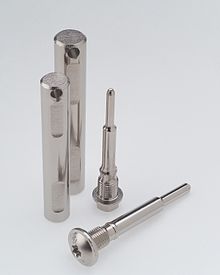
Back طلي لاكهربائي بالنيكل Arabic Chemisch Nickel German Niquelado químico Spanish آبکاری الکترولس نیکل Persian 無電解ニッケルめっき Japanese Bezprądowe powlekanie niklem Polish

Electroless nickel-phosphorus plating, also referred to as E-nickel, is a chemical process that deposits an even layer of nickel-phosphorus alloy on the surface of a solid substrate, like metal or plastic. The process involves dipping the substrate in a water solution containing nickel salt and a phosphorus-containing reducing agent, usually a hypophosphite salt.[1] It is the most common version of electroless nickel plating (EN plating) and is often referred by that name. A similar process uses a borohydride reducing agent, yielding a nickel-boron coating instead.
Unlike electroplating, processes in general do not require passing an electric current through the bath and the substrate; the reduction of the metal cations in solution to metallic is achieved by purely chemical means, through an autocatalytic reaction. This creates an even layer of metal regardless of the geometry of the surface – in contrast to electroplating which suffers from uneven current density due to the effect of substrate shape on the electric resistance of the bath and therefore on the current distribution within it.[2] Moreover, it can be applied to non-conductive surfaces.
It has many industrial applications, from merely decorative to the prevention of corrosion and wear. It can be used to apply composite coatings, by suspending suitable powders in the bath.[3]